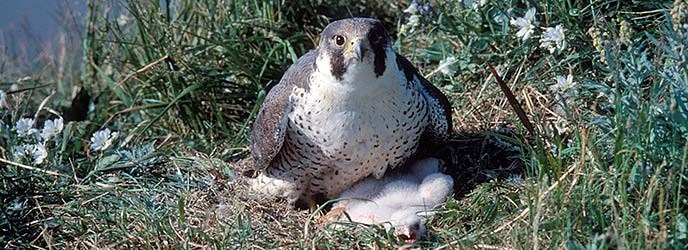
NPS Photo/Big Bend National Park |
|
"The peregrine is without dispute the most nearly perfect flying machine in existence" —Phillip Callahan, The Magnificent Birds of Prey Peregrine Falcons in Big Bend National Park The peregrine falcon (Falco peregrinus) inhabits every continent but Antarctica. Peregrinus, Latin for wandering, reflects its capability of covering great distances. A flat powered flight of 60 mph enables the peregrine to maintain an extensive hunting area, up to 17 miles from a nest site. With strong talons, notched beak, and keen eyesight, the peregrine is a well-adapted hunter. Prey, most often birds, are caught on the wing. After spotting its prey, the peregrine dives at speeds of 150 to 200 mph. The peregrine grabs prey with both feet and breaks the neck. Its position at the top of its food chain makes the peregrine vulnerable to the threats of organo-chlorine pesticides (DDT). Widespread use of pesticides led to a major decline in peregrine numbers and, eventually, to their listing as an endangered species. Compounds accumulate in the bird as it ages and lead to difficulty in breeding. The most obvious threat is egg shell thinning that promotes breakage during the incubation period. Thinner shells also lose moisture faster and the chick dies as the egg dries out. This, combined with infertility and reported abnormal behavior during parenting, has led to many failed nesting attempts. Although DDT has been banned in the U.S. since the 1970s, it enters the chain when the peregrines’ prey eat grains or insects that have picked up DDT. If DDT runoff enters a river, such as the Rio Grande, it flows downstream. Many insects lay eggs and their larvae develop in the river. These tiny creatures pick up small traces of DDT and retain the poison within their body tissues. Upon hatching, many of these insects are consumed by the thousands by birds such as phoebes and swallows which get a strong dose of DDT in return. Phoebes and swallows are eaten by hungry peregrines, which now become contaminated. This DDT poisoning may begin thousands of miles away in the wintering grounds of swallows. Those swallows migrate to Big Bend and become food for peregrines which in turn pick up a long-distance dose of DDT. Pairs usually begin nesting by March. Nesting sites (eyries) are most often found on high cliff faces in the wild, but are also found on the ledges of high buildings in cities. The nest is made by clearing a small area in the stones or sand. The female lays three to four reddish brown eggs that are incubated 33 days by both parents. At six weeks, the young take their first flights and learn to catch prey in midair dropped to them by their parents. They remain with their parents until autumn. Most will not nest until they are two years old. Nesting peregrines are bothered by loud inconsistent noises and nests may fail with too many interruptions. At Big Bend, peregrines are protected throughout the breeding season by the closure of the Mariscal Rim, the East and Southeast Rims of the Chisos Mountains, and the prohibition of motored boats in all three river canyons. |
Last updated: February 24, 2015
